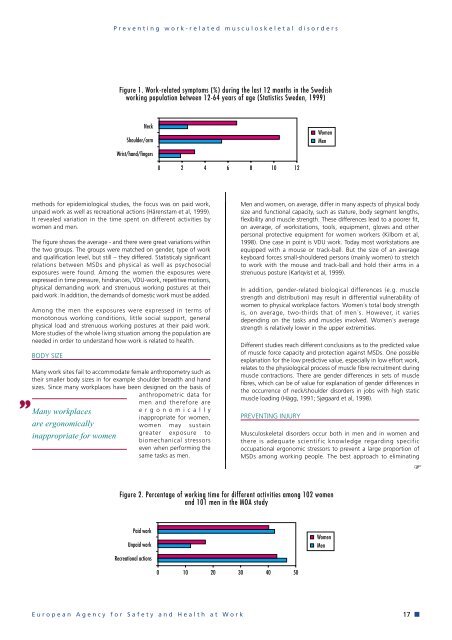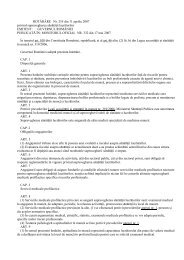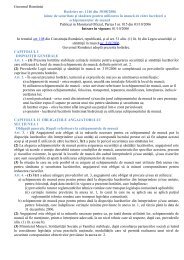Preventing work-related musculoskeletal disorders - European ...
Preventing work-related musculoskeletal disorders - European ...
Preventing work-related musculoskeletal disorders - European ...
You also want an ePaper? Increase the reach of your titles
YUMPU automatically turns print PDFs into web optimized ePapers that Google loves.
<strong>Preventing</strong> <strong>work</strong>-<strong>related</strong> <strong>musculoskeletal</strong> <strong>disorders</strong><br />
Figure 1. Work-<strong>related</strong> symptoms (%) during the last 12 months in the Swedish<br />
<strong>work</strong>ing population between 12-64 years of age (Statistics Sweden, 1999)<br />
Neck<br />
Shoulder/arm<br />
Women<br />
Men<br />
Wrist/hand/fingers<br />
0 2 4 6 8 10 12<br />
methods for epidemiological studies, the focus was on paid <strong>work</strong>,<br />
unpaid <strong>work</strong> as well as recreational actions (Härenstam et al, 1999).<br />
It revealed variation in the time spent on different activities by<br />
women and men.<br />
The figure shows the average - and there were great variations within<br />
the two groups. The groups were matched on gender, type of <strong>work</strong><br />
and qualification level, but still – they differed. Statisticaly significant<br />
relations between MSDs and physical as well as psychosocial<br />
exposures were found. Among the women the exposures were<br />
expressed in time pressure, hindrances, VDU-<strong>work</strong>, repetitive motions,<br />
physical demanding <strong>work</strong> and strenuous <strong>work</strong>ing postures at their<br />
paid <strong>work</strong>. In addition, the demands of domestic <strong>work</strong> must be added.<br />
Among the men the exposures were expressed in terms of<br />
monotonous <strong>work</strong>ing conditions, little social support, general<br />
physical load and strenuous <strong>work</strong>ing postures at their paid <strong>work</strong>.<br />
More studies of the whole living situation among the population are<br />
needed in order to understand how <strong>work</strong> is <strong>related</strong> to health.<br />
BODY SIZE<br />
Many <strong>work</strong> sites fail to accommodate female anthropometry such as<br />
their smaller body sizes in for example shoulder breadth and hand<br />
sizes. Since many <strong>work</strong>places have been designed on the basis of<br />
anthropometric data for<br />
men and therefore are<br />
Many <strong>work</strong>places<br />
ergonomically<br />
inappropriate for women,<br />
are ergonomically<br />
women may sustain<br />
greater exposure to<br />
inappropriate for women<br />
biomechanical stressors<br />
even when performing the<br />
same tasks as men.<br />
Men and women, on average, differ in many aspects of physical body<br />
size and functional capacity, such as stature, body segment lengths,<br />
flexibility and muscle strength. These differences lead to a poorer fit,<br />
on average, of <strong>work</strong>stations, tools, equipment, gloves and other<br />
personal protective equipment for women <strong>work</strong>ers (Kilbom et al,<br />
1998). One case in point is VDU <strong>work</strong>. Today most <strong>work</strong>stations are<br />
equipped with a mouse or track-ball. But the size of an average<br />
keyboard forces small-shouldered persons (mainly women) to stretch<br />
to <strong>work</strong> with the mouse and track-ball and hold their arms in a<br />
strenuous posture (Karlqvist et al, 1999).<br />
In addition, gender-<strong>related</strong> biological differences (e.g. muscle<br />
strength and distribution) may result in differential vulnerability of<br />
women to physical <strong>work</strong>place factors. Women´s total body strength<br />
is, on average, two-thirds that of men´s. However, it varies<br />
depending on the tasks and muscles involved. Women´s average<br />
strength is relatively lower in the upper extremities.<br />
Different studies reach different conclusions as to the predicted value<br />
of muscle force capacity and protection against MSDs. One possible<br />
explanation for the low predictive value, especially in low effort <strong>work</strong>,<br />
relates to the physiological process of muscle fibre recruitment during<br />
muscle contractions. There are gender differences in sets of muscle<br />
fibres, which can be of value for explanation of gender differences in<br />
the occurrence of neck/shoulder <strong>disorders</strong> in jobs with high static<br />
muscle loading (Hägg, 1991; Sjøgaard et al, 1998).<br />
PREVENTING INJURY<br />
Musculoskeletal <strong>disorders</strong> occur both in men and in women and<br />
there is adequate scientific knowledge regarding specific<br />
occupational ergonomic stressors to prevent a large proportion of<br />
MSDs among <strong>work</strong>ing people. The best approach to eliminating<br />
<br />
Figure 2. Percentage of <strong>work</strong>ing time for different activities among 102 women<br />
and 101 men in the MOA study<br />
Paid <strong>work</strong><br />
Unpaid <strong>work</strong><br />
Women<br />
Men<br />
Recreational actions<br />
0 10 20 30 40 50<br />
<strong>European</strong> Agency for Safety and Health at Work<br />
17








